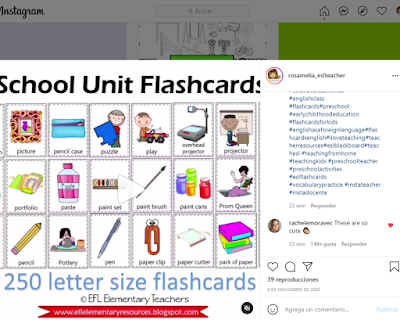I updated the school unit
flashcards. I thought that adding more words and using nicer clipart would be a
bonus for teachers. Many of you have bought it and now you will have both
versions. If there are words that you would like me to add, let me know.
More than 250 flashcards for the classroom objects on
this resource and just a few tips on how to use them in class. You can use my flashcards or the ones that come with your book series.Link:
https://www.teacherspayteachers.com/Product/School-Theme-Flashcards-for-ELL-836917
https://www.teacherspayteachers.com/Product/School-Theme-Flashcards-for-ELL-836917
Check the flashcards:
Watch the video using the flashcards.
Flashcards 1.
If your students are a little more advanced review there is and there
are. Divide the board in two and write the phrases. I used pencil and
books.
Teacher: There is a pencil. There are books.
Students
can find more flashcards to make more examples.
Flashcards 2.
I always find labeling fun. You can do one the board as an example. Label the
body parts, clothes and school objects.(Labeling)
Teacher: name the body parts.
Students: mouth! Eyes! Leg!
Teacher: name the clothes.
Students: dress! shoe!
Teacher: name the school objects.
Students: lunch bag! backpack!
Then, assign red for body
parts. Ask students to name all the body parts and you circle them. Do the same
for clothes and school objects.
Students can do the same using
the flashcards. I placed the flashcard into a plastic sheet to go on paperless.
Have the students use a blue whiteboard marker for labeling the body parts.
Then, use a black whiteboard
marker for labeling the clothes and the school objects.
Flashcards 3. Select
a letter of the alphabet and have the students say all the words that start
with the letter. As they name the word place the flashcard on the board. Then,
have the students do the same on their notebooks with another letter. I chose
letter P for this example.
Flashcards 4. Order
alphabetically. Write the letters from A to Z on the board and the students
find the flashcards to place under each letter.

Flashcards 5. Classroom
Monsters. Give a flashcard on a plastic sheet to each student and have
them create a monster. I did this one with scissors. I added hair, eyes, nose,
mouth, shoes. I guess students are more creative than me, but it will work to
show the students the task before they start their own. Students can show their
work to the class.
Student: This is my
scissors monster. It has black hair. Its eyes are blue and big. It is happy.
She is wearing shoes.
Flashcards 6. Sorting
the flashcards into categories. I wrote these categories on the board. Students
find the flashcards for each category.
Flashcards 7.
Name
the flashcard. Make a grid on the board using the flashcards. I did
this simple one as an example for you.
Teacher: C3!
Students: pencil case!
Flashcards 8. Related
words! I placed the pencil case flashcard in the middle of the board.
Have the students name all the things that a person can find in a pencil case.
As they name the words, place the flashcard or write the word. This is like doing a mind map.
Flashcards 9. Use
puzzles when working with the little ones.
This is my Instagram Account. https://www.instagram.com/rosamelia_eslteacher/
Follow me!!




















































